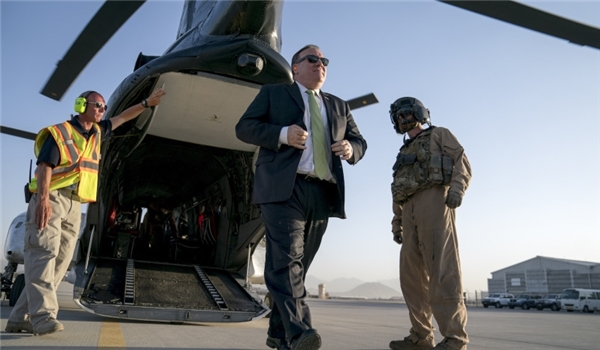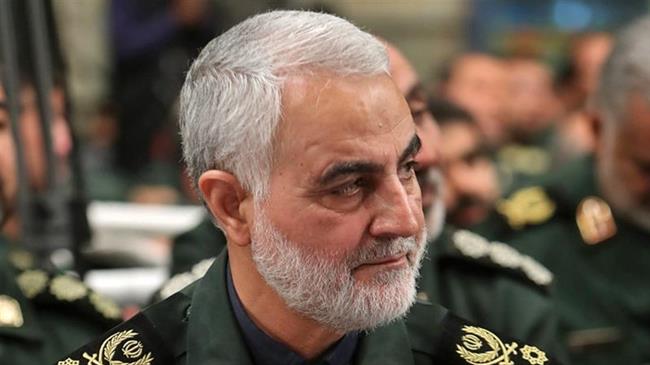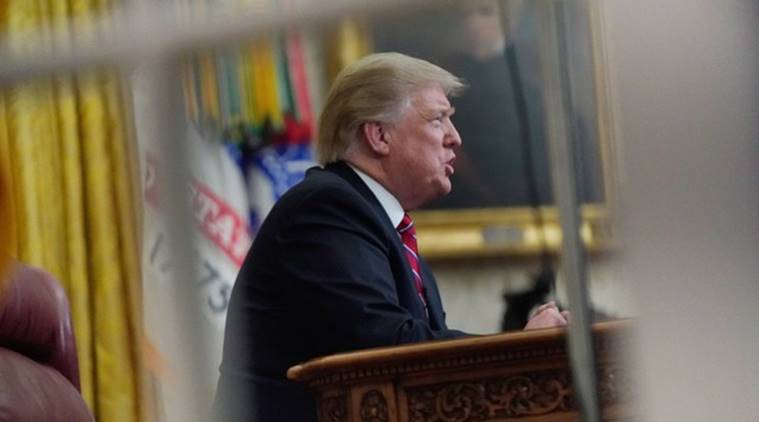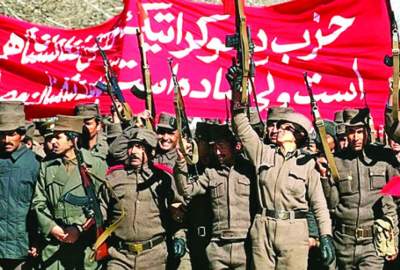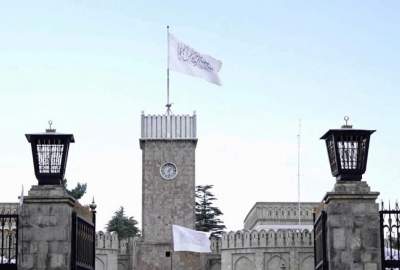President Donald Trump’s administration is considering reducing its diplomatic footprint in Afghanistan as part of a broader effort to extricate the United States from its costly and deadly 18-year conflict, US officials told Foreign Policy.
Publish dateSunday 7 April 2019 - 21:11
Story Code : 182841
AVA- The State Department is preparing to cut by half the number of US diplomats posted in Kabul in 2020, according to three US officials familiar with internal deliberations. It may also advance plans to reduce the number of diplomats posted to the US Embassy in Iraq as Washington winds down its war footing in the Middle East and South Asia to prepare for what it calls an era of “great-power competition” with China and Russia.
The deliberations coincide with US peace talks with the Taliban and assessments on how to withdraw US military forces from Afghanistan.
Once obscure diplomatic outposts, the US embassies in Kabul and Baghdad ballooned into the largest and costliest diplomatic missions in the world following US military interventions there. Diplomats comprise only a portion of embassy personnel in both Kabul and Baghdad, which includes officials from other federal agencies, contractors, and security staff.
In February, NPR reported on a leaked internal document from the US Embassy in Kabul that called the outpost too big and urged a “comprehensive review” of its size, though the document did not outline the scale of the proposed cuts.
The State Department’s presence in Afghanistan pales in comparison to the US military’s, but the embassy in Kabul, along with the embassy in Baghdad, makes up a disproportionate size of State’s budget and personnel compared with embassies in other parts of the world. Some diplomats believe it’s time to shift those resources elsewhere.
“We are regularly hearing from Africa that we are outnumbered by the Chinese diplomats working on economic or other issues 4 or 5 to 1,” said a senior State Department official, who spoke on condition of anonymity, adding, “We cannot continue to concentrate all that money in Afghanistan and Iraq.”
It’s a matter of “where can we best deploy our very limited resources to avoid losing further ground to major competitors who are rising at a speed that we can barely comprehend”, the official stressed.
The plans under consideration envision eliminating only 20 to 30 diplomatic positions this year from Iraq, where the US diplomatic mission includes the embassy in Baghdad and the consulate in Erbil. Up to 30 to 50 percent of the mission to Iraq could be cut in 2020, two of the US officials said, providing details of plans that have been in the works for months.
The embassy in Baghdad has around 16,000 staff, 2,000 of whom are diplomats, according to a New York Times report in February that outlined some of the plans.
The State Department does not publicly discuss precise numbers of personnel at embassies or consulates for security reasons, according to a State Department spokesperson.
“The Department regularly reviews our presence at our overseas missions to reflect changing circumstances and our policy goals. While we do not discuss personnel numbers, our embassies engage in regular reviews to ensure that they are appropriately staffed,” the spokesperson said in an email response to questions on proposed cuts in Afghanistan and Iraq.
“We are not abandoning Iraq and US Embassy Baghdad and our Consulate in Erbil will continue vigorous engagement in Iraq,” the spokesperson stated, adding that the embassy “just completed an exercise to ensure adequate and appropriate staffing to carry out our mission in Iraq”.
James Dobbins, a former career diplomat and special envoy for Afghanistan under the George W. Bush administration, announced that it would make sense to pare down the US diplomatic presence in Afghanistan if the United States can make progress on peace negotiations with the Taliban.
He noted that the type of support Washington continues to provide to Afghanistan after troops leave, including economic development and aid to civil society groups, is more important than tallying up the number of diplomats on the ground.
Stability in Afghanistan largely hinges on whether Trump’s representative to the peace talks, Zalmay Khalilzad, can successfully negotiate a lasting agreement, said Dobbins, now with Rand Corp, adding, “I’ve always thought that the pursuit of a peace agreement was a long shot—worth trying but not something you could count on.”
“The President has made clear that his priority is ending the war in Afghanistan through a sustainable peace settlement and focusing on counterterrorism,” the State Department spokesperson said, adding, “Future staffing at Embassy Kabul will reflect the priorities outlined by the President.”
Other officials quietly fear a diplomatic drawdown may be misguided. The peace talks have not yet concluded, violence continues to ravage many parts of Afghanistan, and the Taliban have incrementally snatched up more territorial control of the country from the government. Diplomats, they say, play an important role in boosting economic and political stability that fall outside the military’s purview.
According to the United Nations, last year marked the deadliest year for Afghan civilians since it began tracking casualties in 2009. The UN mission in Afghanistan reported that 3,804 civilians were killed and 7,189 were wounded.
An unusual public spat between Washington and Kabul has further complicated the slow-moving talks with the Taliban. A senior Afghan official accused Khalilzad last month of conspiring to replace the current Afghan government with a colonial-style one and freezing Afghans out of negotiations with the Taliban. The United States flatly denied the accusations.
The US Embassy in Afghanistan is not a traditional embassy. As with Baghdad, it is a massive and largely self-sufficient complex, staffed by thousands of personnel, contractors, and local staff. Reducing the size of the embassy would be a complicated logistical undertaking with significant security considerations.
“You have to think of the embassy in Afghanistan not just as a place people go to work but more like a college campus … in a very insecure environment,” said Laurel Miller, a former US diplomat who worked on Afghanistan and is now at the International Crisis Group.
“The embassy is going to have to be ahead of the curve on a military drawdown, not behind the curve on a military drawdown,” she added.
In late 2018, conflicting reports emerged that Trump asked the Pentagon to draw up plans to cut the number of US troops in Afghanistan from 14,000 to 7,000. The plans coincided with Trump’s abrupt announcement he was withdrawing US forces from Syria, drawing fierce criticism from US lawmakers and leading to the resignation of Defense Secretary James Mattis.
The White House later denied the plan to cut troop numbers in Afghanistan and walked back the decision on Syria. But Trump appears keen to fulfill campaign promises to finally extricate the US military from its long and costly involvement in Afghanistan.
In addition to the 14,000 US troops, there are about 8,000 NATO and allied troops currently deployed to the country under NATO’s Resolute Support mission, which focuses on training and advising Afghan security forces. The Afghanistan conflict, the longest military engagement in US history, has claimed the lives of about 2,300 Americans.
Some experts also question whether reducing the number of US diplomats at the embassy will have a major impact, given their confinements to the embassy in Kabul due to the security risks. C. Christine Fair, a professor at Georgetown University and an expert on the region, said many US diplomats ferry between the nearby air base and “Fortress America”—the US Embassy—without ever venturing out beyond the security perimeter, which limits their effectiveness.
The deliberations coincide with US peace talks with the Taliban and assessments on how to withdraw US military forces from Afghanistan.
Once obscure diplomatic outposts, the US embassies in Kabul and Baghdad ballooned into the largest and costliest diplomatic missions in the world following US military interventions there. Diplomats comprise only a portion of embassy personnel in both Kabul and Baghdad, which includes officials from other federal agencies, contractors, and security staff.
In February, NPR reported on a leaked internal document from the US Embassy in Kabul that called the outpost too big and urged a “comprehensive review” of its size, though the document did not outline the scale of the proposed cuts.
The State Department’s presence in Afghanistan pales in comparison to the US military’s, but the embassy in Kabul, along with the embassy in Baghdad, makes up a disproportionate size of State’s budget and personnel compared with embassies in other parts of the world. Some diplomats believe it’s time to shift those resources elsewhere.
“We are regularly hearing from Africa that we are outnumbered by the Chinese diplomats working on economic or other issues 4 or 5 to 1,” said a senior State Department official, who spoke on condition of anonymity, adding, “We cannot continue to concentrate all that money in Afghanistan and Iraq.”
It’s a matter of “where can we best deploy our very limited resources to avoid losing further ground to major competitors who are rising at a speed that we can barely comprehend”, the official stressed.
The plans under consideration envision eliminating only 20 to 30 diplomatic positions this year from Iraq, where the US diplomatic mission includes the embassy in Baghdad and the consulate in Erbil. Up to 30 to 50 percent of the mission to Iraq could be cut in 2020, two of the US officials said, providing details of plans that have been in the works for months.
The embassy in Baghdad has around 16,000 staff, 2,000 of whom are diplomats, according to a New York Times report in February that outlined some of the plans.
The State Department does not publicly discuss precise numbers of personnel at embassies or consulates for security reasons, according to a State Department spokesperson.
“The Department regularly reviews our presence at our overseas missions to reflect changing circumstances and our policy goals. While we do not discuss personnel numbers, our embassies engage in regular reviews to ensure that they are appropriately staffed,” the spokesperson said in an email response to questions on proposed cuts in Afghanistan and Iraq.
“We are not abandoning Iraq and US Embassy Baghdad and our Consulate in Erbil will continue vigorous engagement in Iraq,” the spokesperson stated, adding that the embassy “just completed an exercise to ensure adequate and appropriate staffing to carry out our mission in Iraq”.
James Dobbins, a former career diplomat and special envoy for Afghanistan under the George W. Bush administration, announced that it would make sense to pare down the US diplomatic presence in Afghanistan if the United States can make progress on peace negotiations with the Taliban.
He noted that the type of support Washington continues to provide to Afghanistan after troops leave, including economic development and aid to civil society groups, is more important than tallying up the number of diplomats on the ground.
Stability in Afghanistan largely hinges on whether Trump’s representative to the peace talks, Zalmay Khalilzad, can successfully negotiate a lasting agreement, said Dobbins, now with Rand Corp, adding, “I’ve always thought that the pursuit of a peace agreement was a long shot—worth trying but not something you could count on.”
“The President has made clear that his priority is ending the war in Afghanistan through a sustainable peace settlement and focusing on counterterrorism,” the State Department spokesperson said, adding, “Future staffing at Embassy Kabul will reflect the priorities outlined by the President.”
Other officials quietly fear a diplomatic drawdown may be misguided. The peace talks have not yet concluded, violence continues to ravage many parts of Afghanistan, and the Taliban have incrementally snatched up more territorial control of the country from the government. Diplomats, they say, play an important role in boosting economic and political stability that fall outside the military’s purview.
According to the United Nations, last year marked the deadliest year for Afghan civilians since it began tracking casualties in 2009. The UN mission in Afghanistan reported that 3,804 civilians were killed and 7,189 were wounded.
An unusual public spat between Washington and Kabul has further complicated the slow-moving talks with the Taliban. A senior Afghan official accused Khalilzad last month of conspiring to replace the current Afghan government with a colonial-style one and freezing Afghans out of negotiations with the Taliban. The United States flatly denied the accusations.
The US Embassy in Afghanistan is not a traditional embassy. As with Baghdad, it is a massive and largely self-sufficient complex, staffed by thousands of personnel, contractors, and local staff. Reducing the size of the embassy would be a complicated logistical undertaking with significant security considerations.
“You have to think of the embassy in Afghanistan not just as a place people go to work but more like a college campus … in a very insecure environment,” said Laurel Miller, a former US diplomat who worked on Afghanistan and is now at the International Crisis Group.
“The embassy is going to have to be ahead of the curve on a military drawdown, not behind the curve on a military drawdown,” she added.
In late 2018, conflicting reports emerged that Trump asked the Pentagon to draw up plans to cut the number of US troops in Afghanistan from 14,000 to 7,000. The plans coincided with Trump’s abrupt announcement he was withdrawing US forces from Syria, drawing fierce criticism from US lawmakers and leading to the resignation of Defense Secretary James Mattis.
The White House later denied the plan to cut troop numbers in Afghanistan and walked back the decision on Syria. But Trump appears keen to fulfill campaign promises to finally extricate the US military from its long and costly involvement in Afghanistan.
In addition to the 14,000 US troops, there are about 8,000 NATO and allied troops currently deployed to the country under NATO’s Resolute Support mission, which focuses on training and advising Afghan security forces. The Afghanistan conflict, the longest military engagement in US history, has claimed the lives of about 2,300 Americans.
Some experts also question whether reducing the number of US diplomats at the embassy will have a major impact, given their confinements to the embassy in Kabul due to the security risks. C. Christine Fair, a professor at Georgetown University and an expert on the region, said many US diplomats ferry between the nearby air base and “Fortress America”—the US Embassy—without ever venturing out beyond the security perimeter, which limits their effectiveness.
avapress.com/vdcdox0ffyt0jj6.em2y.html
Tags
Top hits
3
